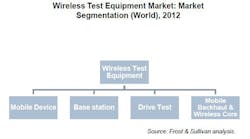With the plethora of wireless technologies and products being used today, a variety of factors is clearly driving the global market for wireless test equipment. Examples include higher mobility, escalating mobile-data traffic growth, and the adoption of Long Term Evolution (LTE) and LTE-Advanced (LTE-A) deployments. Beyond those factors, the increasing adoption of smart devices in particular is playing a key role in creating today’s demands for wireless test equipment.
In a research report from Frost & Sullivan, “Global Wireless Test Equipment Market,” analysts found that the market saw revenue of more than $3.38 billion in 2012. It is expected to reach $5.57 billion in 2019 at a compound annual growth rate (CAGR) of 7.4%. The researchers found that the demand for test equipment is on the rise because it facilitates early-market delivery while aiding the entire supply chain throughout the R&D cycle. The report covers a variety of product segments including mobile-device, base-station, drive, and mobile-backhaul and wireless-core test equipment, which also are segmented by geographic region.
Because wireless technologies are more complex than fixed networks—especially regarding LTE and LTE-A—test equipment has proven to be increasingly crucial in ensuring that products comply with industry standards. There are, however, some factors that could hinder the development of the test-equipment market. For example, the increasing rise in data rates hasn’t yet translated into revenue for service providers, which negatively affects their investment in test equipment. The need to upgrade network infrastructures to newer technologies, such as LTE, takes another sizeable chunk out of profitable revenue.
Major players recognized in the report include Agilent Technologies, Anritsu, and Rohde & Schwarz. Other vendors include LitePoint/Teradyne, Anite, Spirent Communications, Ixia, Aeroflex, JDSU, and National Instruments. The report notes a trend: Test-equipment companies are increasingly adopting direct distribution channels for sales, due to the growing need for a global presence strategy and the demand for wireless test solutions.
